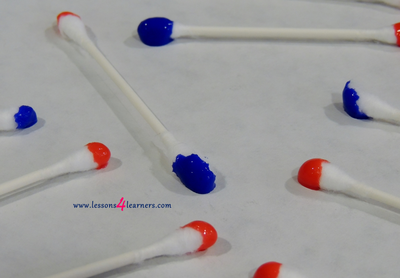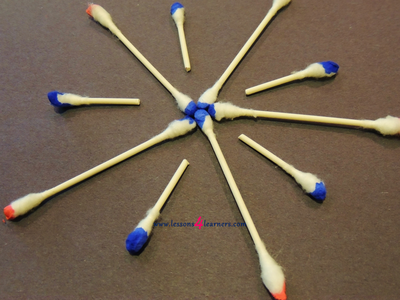Q-Tip Fireworks
Lesson Plan:
|
Activity:
Q-Tip Fireworks
Lesson plan developed by Ms. Erika Geelhoed, BA Ed
Age Group:
* Lesson plan objective and assessment can be adapted to use this activity with school-age children.
Objectives:
Children will:
|
|
II.7.4a
Materials:
|
Procedure:
- Have children help you dip the Q-tips into the blue and red paint.
- Cut them into different lengths and allow them to dry.
- When ready, lay out materials in an appropriate area and allow the children to create their fireworks by gluing the Q-tips to the black paper.
- **Do not tell children how to arrange their Q-tips. It is our job as educators to promote art that is open-ended instead of focusing on the finished product**
- As the children are working ask them to tell you about their artwork.
- You can ask questions like:
- What is your favorite part of the picture?
- What title would you give this picture?
- If you were doing this again, what would you do differently? Why?
- Asking the children questions like these encourages them to reflect on the creation process and promotes higher-level thinking.
Assessment:
- Observe and record the children as they are creating. What did they have to say about their artwork? Were they excited to share it? Be sure to record any conversations the student has with you or other children during the activity.
Click on the course icon for enrollment information.
Creative Arts
Creative arts development promotes creativity, individual expression, self-esteem, imagination, and appreciation of cultural diversity. Through music, movement, visual arts, and dramatic arts, young children are encouraged to explore and express themselves creatively.
Creative expression is important for many reasons, but partially because it supports children’s cognitive growth, problem-solving skills, and growing insight into the world around them. Creative arts provides children with an opportunity to explore and express him/herself in ways that stimulate brain growth and experience in many expressions of human intelligence. Such opportunities help children to develop their talents and recognize their own uniqueness.
Creative expression is important for many reasons, but partially because it supports children’s cognitive growth, problem-solving skills, and growing insight into the world around them. Creative arts provides children with an opportunity to explore and express him/herself in ways that stimulate brain growth and experience in many expressions of human intelligence. Such opportunities help children to develop their talents and recognize their own uniqueness.










